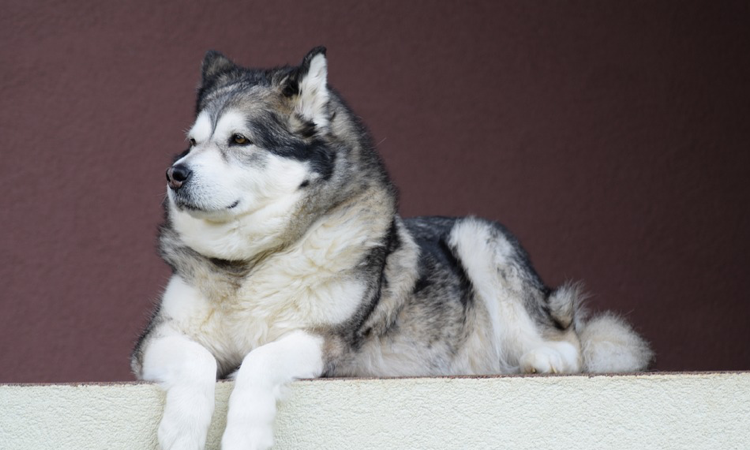As strong as it is silent, once you see the wag of an Alaskan Malamute’s plumed tail you’ll be hard-pushed to turn back. This wolfish-looking dog carries itself with a regal stature and for good reason; the Malamute is one of the oldest dog breeds in history. Despite their size, the Alaskan Malamute is a gentle soul who wants to be friends with everyone they meet. Far from a guard dog, this breed is best suited to pulling your kids along on a sledge or digging a spectacular hole in the back garden.
Facts
Breed Group: Working
Size: Large
Sheds?: Yes
Coat length: Medium
Exercise: Lots of exercise – at least two hours per day
Grooming required?: Every day
History
Go back a few thousand years and you’ll see the Alaskan Malamute’s ancestors crossing the land bridge from Siberia to Alaska. One tribe, the Mahlemut (hence the name), settled in the north-eastern Seward Peninsula and it’s there that the Alaskan Malamute was first bred. At that time, the breed was used to hunt seals and pull heavy sledges. The Alaskan Malamute is one of the oldest Arctic sled dogs where you can still spot them at work today, as well as now being a much-loved family pet.
Health
You can expect your Alaskan Malamute to live between 10-12 years. They are generally healthy dogs, having evolved to withstand some of the harshest outdoor conditions, but can be prone to hip dysplasia and hereditary cataracts.
Characteristics
Cheeky cheerleaders
Despite not being big-time barkers, Malamutes are known for the characteristic “woo-woo” sound they make. With training, this can be taught to be done on cue as their way of saying please or thank you or to simply cheer you along during your day.
Naturally curious
Alaskan Malamutes may look like an imposing guard dog type but they’re actually superb people-pleasers and love making friends with everyone they meet. From the postman to the neighbours, expect your Malamute to jump at the chance of a paw-shake with any passers-by. Their naturally curious disposition makes them great family dogs, although their curiosity may often extend to putting their paws on your shoulder to look you in the eye, which can be surprising for those not in the know.
Mega active
The Alaskan Malamute is not for the lazy-hearted. This breed loves to be outdoors and active. Keep them inside for too long and you may find your sofa has become a chew toy. For that reason, they’re best suited to owners who live an active lifestyle where they can become part of every activity.
Training
Like any large working dog, good training from a young age is essential to helping your Alaskan Malamute to become a good canine citizen. Training classes, obedience and socialisation are all key to helping your Malamute understand its role in the pack and how to behave appropriately with other doggy playmates and people. Due to their high-intelligence they’re quick learners and respond well to positive reinforcement. With an instinctive love of work, they can also be taught to pull packs, luggage and to compete in dog sports.
Housebreaking
Owners report that the Alaskan Malamute is easy to housebreak and with a tendency to keep its own coat clean.
Where to find the Alaskan Malamute
Breed Groups
You don’t have to travel to Alaska to find one of these gorgeous dogs, check out one of the many local breed groups we’ve found in the list below.
Celticwolf Alaskan Malamutes
Chayo Alaskan Malamutes
Snobruk Alaskan Malamutes UK
The Alaskan Malamute Club of the UK
Snowshoes Alaskan Malamutes
Breeders
Find an Alaskan Malamute with peace of mind by using this list of Kennel Club assured breeders (KCAB).
Adopt an Alaskan Malamute
Alaskan Malamutes can live up to 15 years so there’s plenty of life in the old dog yet, for previous pets and retired sled-pullers.
Alaskan Malamute Rescue
Saints Sled Dog Rescue
Siberian Husky & Malamute Dog Rescue (SASD)
Do you own an Alaskan Malamute?

If you own an Alaskan Malamute let us know in the comments below and upload your picture to our Facebook, Twitter and Instagram tagging @DogBuddyCo.